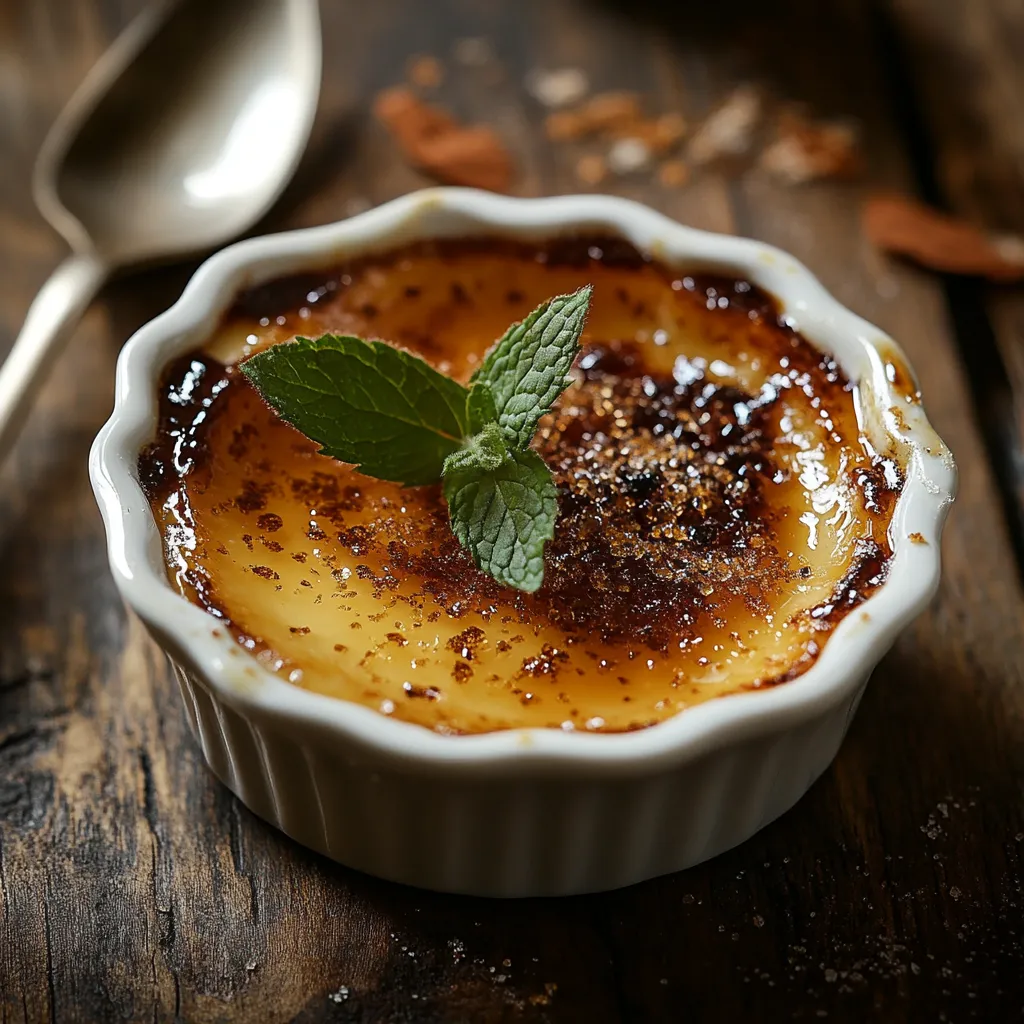Discover the rich and creamy essence of crème brûlée, exploring its history, ingredients, and preparation secrets.
Crème brûlée, a symbol of sophistication and indulgence, is more than just a dessert—it’s an experience. This beloved French delicacy combines a silky custard base with a caramelized sugar topping, creating a contrast of textures that tantalizes the senses. While its presentation is simple, the artistry behind its preparation is profound. In this article, we’ll unravel what goes into making crème brûlée, its historical roots, and the delicate techniques that turn it into a masterpiece.
Part 1: The Essence of Crème Brûlée
Crème brûlée is more than a dessert; it’s a celebration of simplicity meeting luxury. This custard-based treat has captivated palates worldwide, but its allure lies in its minimalism. Using only a handful of ingredients, crème brûlée creates a symphony of textures and flavors that are hard to match.
Understanding the Core Idea
At its heart, crème brûlée is a marriage of rich custard and a crispy, caramelized sugar shell. The contrast between the creamy base and the brittle topping delivers an unforgettable sensory experience. This duality is what makes it an enduring favorite, whether it’s served in fine dining restaurants or prepared lovingly at home.
A Brief Overview of Preparation
The preparation of crème brûlée is deceptively simple. A custard mixture made of heavy cream, egg yolks, sugar, and vanilla extract is carefully baked and chilled. Just before serving, sugar is sprinkled on top and torched to create a brittle, golden crust. This process highlights the dessert’s dual nature: the warmth of caramelized sugar and the cool, creamy custard beneath.
Why It Stands Out Among Desserts
Unlike other desserts that rely on elaborate decorations or bold flavors, crème brûlée excels in subtlety. Its appeal lies in its textures, its delicate vanilla aroma, and the way its ingredients come together harmoniously. Few dishes evoke the same sense of nostalgia and indulgence in a single bite.
Crème brûlée isn’t just a dish—it’s a story of elegance, simplicity, and timelessness, crafted with care and enjoyed with relish. Let’s explore its roots and the ingredients that make it so extraordinary in the sections ahead.
Part 2: Historical Origins of Crème Brûlée
The journey of crème brûlée through history is as fascinating as the dessert itself. Although it’s universally associated with French cuisine, its origins reveal a tapestry of culinary traditions from across Europe.
Tracing Back to Its Roots
The first recorded mention of a custard dessert resembling crème brûlée dates back to the 17th century. Some claim that its true origin lies in England, where a similar dessert, known as “burnt cream,” was served at Trinity College in Cambridge. Others argue that Spain’s crema catalana, with its citrus-infused custard and caramelized topping, predated its French counterpart.
In France, crème brûlée emerged as a hallmark of culinary refinement. The name itself translates to “burnt cream,” highlighting the technique of caramelizing sugar atop the custard. French chefs elevated this dessert into the realm of high art, refining its texture and perfecting its balance of flavors.
Influences from Around the World
Though its French roots are well celebrated, crème brûlée’s popularity owes much to international influences. From the Spanish touch of cinnamon in crema catalana to the English version’s use of cream and sugar, these variations showcase how global cultures shaped this dessert into what it is today.
Why It Became a Classic
The 20th century saw crème brûlée rise to prominence as a symbol of indulgence in fine dining. Its visual appeal—a gleaming, golden crust atop a silky custard—made it a favorite on menus worldwide. Additionally, its simplicity allowed chefs to experiment with flavors while maintaining its classic identity.
Crème brûlée’s rich history reflects its timeless charm. Despite debates over its origins, one thing is certain: this dessert has earned its place as a beloved classic, cherished by food lovers across the globe.
Part 3: Core Ingredients of Crème Brûlée
The magic of crème brûlée lies in its simplicity. Despite using only a few ingredients, each plays a pivotal role in creating the dessert’s luxurious texture and iconic flavor. Let’s take a closer look at what makes crème brûlée so unforgettable.
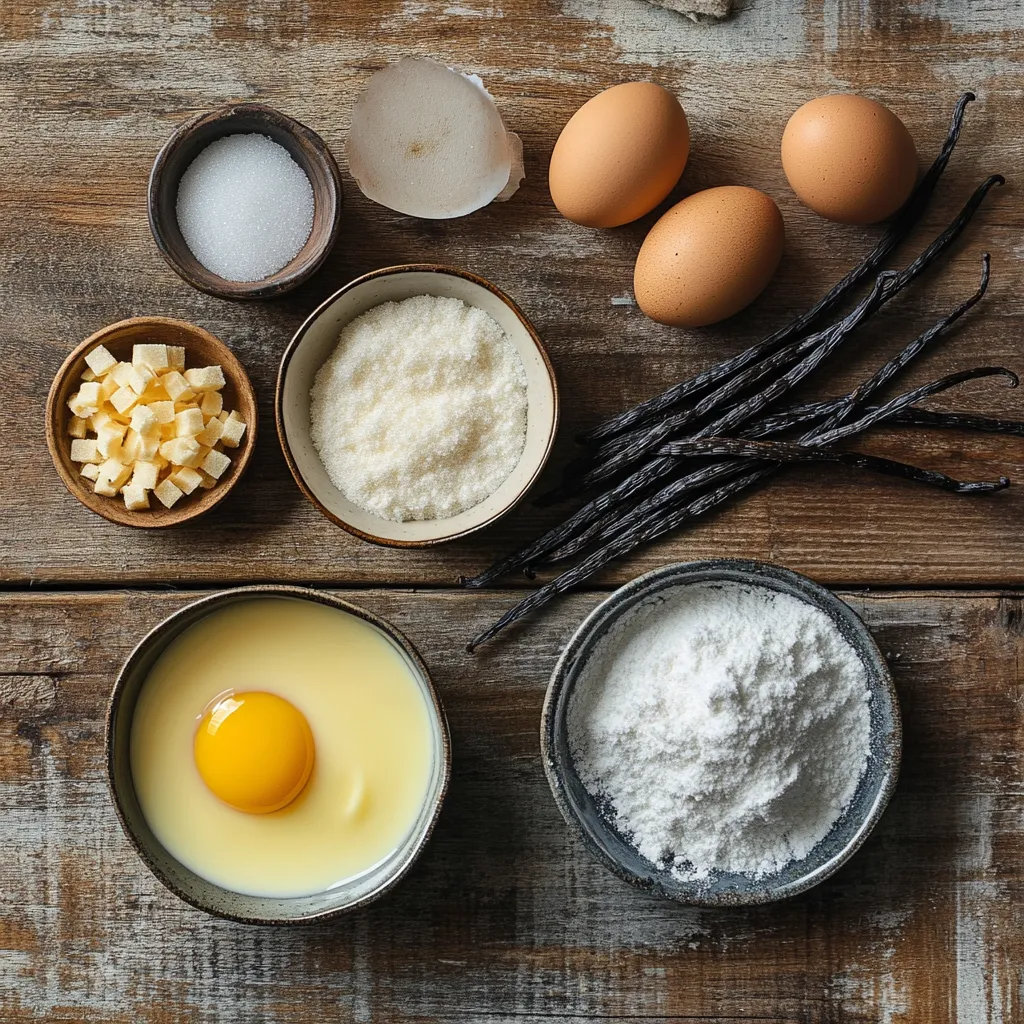
Heavy Cream: The Foundation of Richness
Heavy cream is the backbone of crème brûlée. Its velvety texture and high fat content lend the custard its signature creaminess. When heated, the cream melds seamlessly with the other ingredients, creating a smooth, decadent base that defines this dessert.
Using fresh, high-quality cream is crucial. Inferior cream can result in a custard that’s either too thin or lacking in richness. For an even silkier texture, some recipes may blend heavy cream with whole milk, but cream alone is the traditional choice.
Egg Yolks: The Custard’s Secret Weapon
Egg yolks are the unsung heroes of crème brûlée, providing structure and stability to the custard. When whisked with sugar and gently heated, the proteins in the yolks coagulate, thickening the mixture into a luscious custard.
Beyond texture, egg yolks contribute a subtle richness that enhances the dessert’s flavor. For best results, they must be tempered carefully to prevent curdling, a step that requires patience and precision.
Sugar: The Sweet Element
Sugar serves dual purposes in crème brûlée: sweetening the custard and forming the iconic caramelized topping. When mixed into the custard base, sugar balances the richness of the cream and egg yolks. Its gentle sweetness ensures that the dessert remains light and not overly cloying.
For the topping, granulated sugar is the best choice. When torched or broiled, it melts and hardens into a golden crust, adding a satisfying crunch to every bite. The interplay between this crisp layer and the creamy custard below is what makes crème brûlée so irresistible.
Vanilla: The Quintessential Flavor
No discussion of crème brûlée is complete without mentioning vanilla extract or, even better, real vanilla beans. This aromatic ingredient infuses the custard with a warm, floral flavor that elevates the dessert.
Vanilla beans, with their tiny, aromatic seeds, are the gold standard for crème brûlée. When steeped in cream, they impart a depth of flavor that artificial vanilla can’t match. However, high-quality vanilla extract can still produce delightful results for home bakers.
Optional Ingredients and Flavor Variations
Though the classic recipe sticks to these core ingredients, modern twists on crème brûlée introduce exciting flavors like chocolate, coffee, or citrus zest. These variations add a creative flair while staying true to the dessert’s essence.
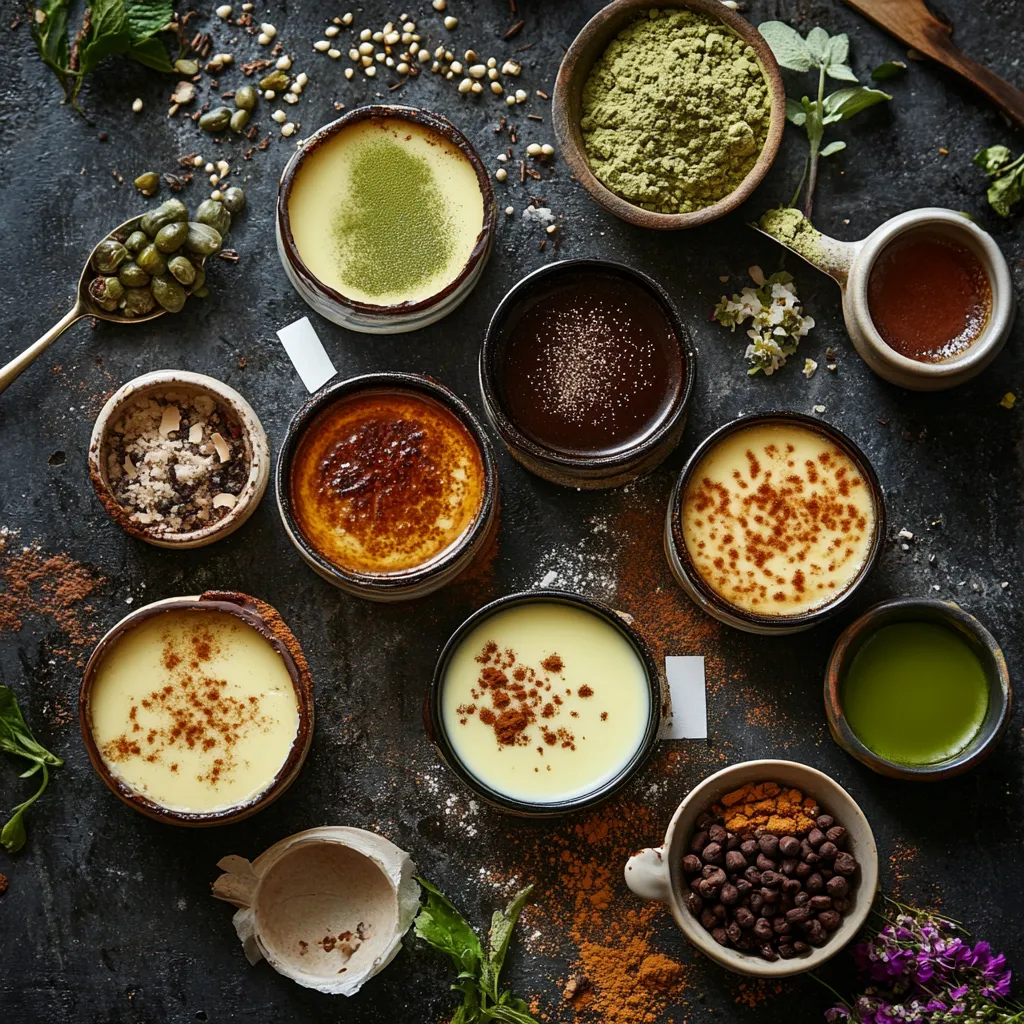
With just four main ingredients, crème brûlée transforms simplicity into culinary artistry, proving that less truly is more.
Part 4: The Role of Heavy Cream in Crème Brûlée
Heavy cream is more than just an ingredient in crème brûlée—it’s the element that brings unparalleled richness and a silky texture to the custard. Without it, the dessert would lose its luxurious mouthfeel and creamy consistency.
Why Heavy Cream Is Essential
The high-fat content in heavy cream is what gives crème brûlée its velvety smoothness. When heated and combined with egg yolks, it forms the base of the custard, creating a structure that’s firm enough to hold its shape but soft enough to melt on the tongue.
Unlike milk or light cream, heavy cream has a density that ensures the custard won’t turn out watery or overly dense. Its balanced creaminess enhances the dessert’s indulgence without overwhelming the palate.
How to Choose the Right Cream
Not all cream is created equal. For the best results, use fresh, high-quality heavy cream with at least 36% fat content. Lower-fat substitutes, like half-and-half, may lead to a thinner custard that lacks the luxurious texture crème brûlée is known for.
Organic cream or cream from grass-fed cows can elevate the flavor even further, adding subtle notes of freshness to the dessert. Avoid ultra-pasteurized creams, as they can sometimes have a slightly altered taste or texture due to the intense heat used in processing.
Enhancing Flavor with Heavy Cream
Heavy cream serves as a neutral canvas that absorbs and carries the flavors of the other ingredients. When steeped with vanilla beans or other aromatics, the cream takes on their essence, infusing the entire custard with a warm, aromatic depth.
Additionally, the gentle heating of the cream ensures that the sugar dissolves smoothly, contributing to the custard’s cohesive texture. This step also helps temper the egg yolks, preventing them from scrambling during the mixing process.
Can You Substitute Heavy Cream?
While heavy cream is irreplaceable for a classic crème brûlée, some variations use a mix of cream and whole milk to lighten the texture slightly. Plant-based creams, such as coconut cream, are also becoming popular in vegan adaptations, but they alter the dessert’s flavor profile significantly.
Heavy cream, with its unmatched richness and versatility, is truly the heart of crème brûlée. It’s the foundation upon which this elegant dessert is built, proving that the simplest ingredients often have the most profound impact.
Part 5: Importance of Egg Yolks in the Custard Base
Egg yolks are the backbone of crème brûlée, providing the structure and texture that define the dessert. Their role goes beyond simply binding the ingredients—they contribute richness, flavor, and the smooth consistency that makes crème brûlée irresistible.
How Egg Yolks Transform the Custard
When mixed with heavy cream and sugar, egg yolks form a delicate custard. Their proteins thicken the mixture as it cooks, creating a silky texture that’s neither too firm nor too runny. The key lies in the slow coagulation of these proteins, which gives crème brûlée its luxurious mouthfeel.
Unlike egg whites, which can create a rubbery texture when overcooked, yolks allow the custard to remain soft and creamy. This is why crème brûlée relies exclusively on yolks for its custard base.
The Science Behind Egg Yolks in Crème Brûlée
Egg yolks contain natural emulsifiers, such as lecithin, which help blend fat and water seamlessly. This is crucial in crème brûlée, as it ensures the heavy cream and sugar integrate into a smooth mixture without separating.
Additionally, the fat in the yolks enhances the dessert’s richness, complementing the cream and sugar perfectly. Yolks also contribute a subtle golden hue to the custard, adding to its visual appeal.
Perfecting the Technique: Tempering the Yolks
A critical step in making crème brûlée is tempering the egg yolks. This involves slowly whisking hot cream into the yolks to raise their temperature gradually. Skipping or rushing this step can cause the yolks to curdle, resulting in a lumpy custard.
Once tempered, the yolks are fully incorporated into the cream, allowing the custard to set beautifully during baking. The process requires patience and care, but the result is well worth the effort.
Alternatives to Egg Yolks in Modern Variations
For those seeking egg-free options, alternatives like cornstarch or agar-agar are sometimes used to thicken the custard. However, these substitutes can’t replicate the creamy richness that yolks provide. Vegan adaptations often rely on coconut milk or cashew cream but deliver a distinctly different flavor and texture.
Egg yolks, with their unique ability to create a smooth, cohesive custard, are truly irreplaceable in a traditional crème brûlée. They’re the unsung heroes that transform simple ingredients into a dessert masterpiece.
Part 6: Sweetening with Sugar
Sugar is a fundamental ingredient in crème brûlée, playing a dual role in sweetening the custard and forming the iconic caramelized topping. Its subtle sweetness balances the richness of the cream and egg yolks while contributing to the dessert’s visual and textural appeal.
Sugar in the Custard
In the custard, sugar dissolves seamlessly into the cream and yolks, enhancing their flavors without overpowering them. The sweetness acts as a counterpoint to the cream’s heaviness, ensuring a well-rounded taste profile.
The type of sugar matters. Granulated sugar is most commonly used because it blends easily into the mixture and provides consistent sweetness. The quantity must be measured carefully to avoid tipping the balance toward being overly sweet, which can detract from the dessert’s elegance.
The Caramelized Sugar Topping
The crowning glory of crème brûlée is its brittle caramelized crust. This golden layer not only adds visual allure but also creates a satisfying crunch that contrasts with the creamy custard beneath. Achieving this crust requires precision and a touch of artistry.
Granulated sugar is sprinkled evenly over the set custard before being caramelized using a culinary torch or broiler. As the sugar heats, it melts and browns, transforming into a hard, glass-like layer with a rich, toasty flavor.
The caramelization process is a delicate balance. Too much heat can burn the sugar, leaving a bitter taste, while too little heat results in a soft, sticky layer. Achieving the perfect crackling crust takes practice but is essential to the dessert’s charm.
Enhancing the Sugar Experience
While white granulated sugar is traditional, some variations incorporate brown sugar or raw cane sugar for a deeper caramel flavor. Flavored sugars infused with vanilla or citrus zest can also add a creative twist.
Additionally, the thickness of the sugar layer affects the experience. A thinner layer allows for an easier crack with a spoon, while a thicker layer provides more crunch but may overpower the custard.
Why Sugar Matters in Crème Brûlée
Beyond its flavor and texture contributions, sugar plays a psychological role in crème brûlée. The act of cracking the caramelized crust with a spoon is a sensory delight, making the dessert as much about the experience as the taste.
From balancing the custard to creating the dessert’s signature topping, sugar is a key player in making crème brûlée unforgettable. Its simplicity belies its significance, proving that even the most basic ingredients can have a profound impact.
Part 7: Vanilla – The Quintessential Flavoring
Vanilla is the soul of crème brûlée, infusing the custard with a warm, aromatic flavor that enhances its creamy richness. Whether sourced from real vanilla beans or high-quality extract, this ingredient transforms the dessert from ordinary to extraordinary.
Why Vanilla Is Essential
Vanilla’s subtle floral and earthy notes complement the custard’s sweetness and creaminess. It brings balance, ensuring the dessert isn’t one-dimensional. The use of vanilla also gives crème brûlée its distinct aroma, a hallmark that lingers enticingly as the dish is served.
Vanilla Beans vs. Vanilla Extract
Vanilla beans are often considered the gold standard for crème brûlée. The seeds inside the pods disperse evenly throughout the custard, creating tiny black specks that are both visually appealing and flavorful. Infusing the cream with split vanilla beans before mixing ensures a deep, authentic taste.
Vanilla extract, while convenient, can also yield excellent results when used sparingly. Opt for pure extract over imitation, as the latter lacks the complexity and depth required for this elegant dessert.
Creative Vanilla Variations
Some chefs experiment with flavored vanilla sugars or vanilla-infused liquors to elevate the custard’s taste. However, simplicity often wins in crème brûlée, where the classic pairing of vanilla with cream and sugar remains timeless.
Vanilla is a small but mighty ingredient, proving that the right flavoring can elevate even the simplest recipes to new heights.
Part 8: Optional Ingredients and Variations
While the traditional crème brûlée recipe remains a classic, creative chefs and home cooks have introduced countless variations, each offering a unique twist on this beloved dessert.
Popular Flavor Additions
- Chocolate Crème Brûlée: Cocoa powder or melted chocolate is mixed into the custard for a richer, more decadent dessert.
- Coffee-Infused Crème Brûlée: A splash of espresso or coffee extract adds a bold, slightly bitter edge.
- Citrus Variations: Zests of lemon, orange, or lime can be infused into the cream for a fresh, tangy flavor.
- Spiced Versions: Cinnamon, nutmeg, or cardamom add warmth and complexity to the custard.
Modern and Seasonal Twists
- Pumpkin Crème Brûlée: A fall-inspired variation that incorporates pumpkin puree and spices.
- Matcha Crème Brûlée: Green tea powder lends an earthy flavor and vibrant color.
- Berry-Infused Variations: Purees of raspberry, strawberry, or blueberry swirl through the custard for a fruity twist.
Dietary-Friendly Adaptations
- Dairy-Free Options: Coconut cream or almond milk can replace heavy cream for lactose-intolerant individuals.
- Sugar-Free Crème Brûlée: Natural sweeteners like stevia or monk fruit can substitute sugar without compromising flavor.
These variations prove that crème brûlée is as versatile as it is delicious, offering endless possibilities for personalization.
Part 9: Preparing the Custard Mixture
The heart of crème brûlée lies in its custard mixture, a delicate blend of cream, egg yolks, sugar, and vanilla. Crafting this mixture requires attention to detail, as even small missteps can impact the final result.
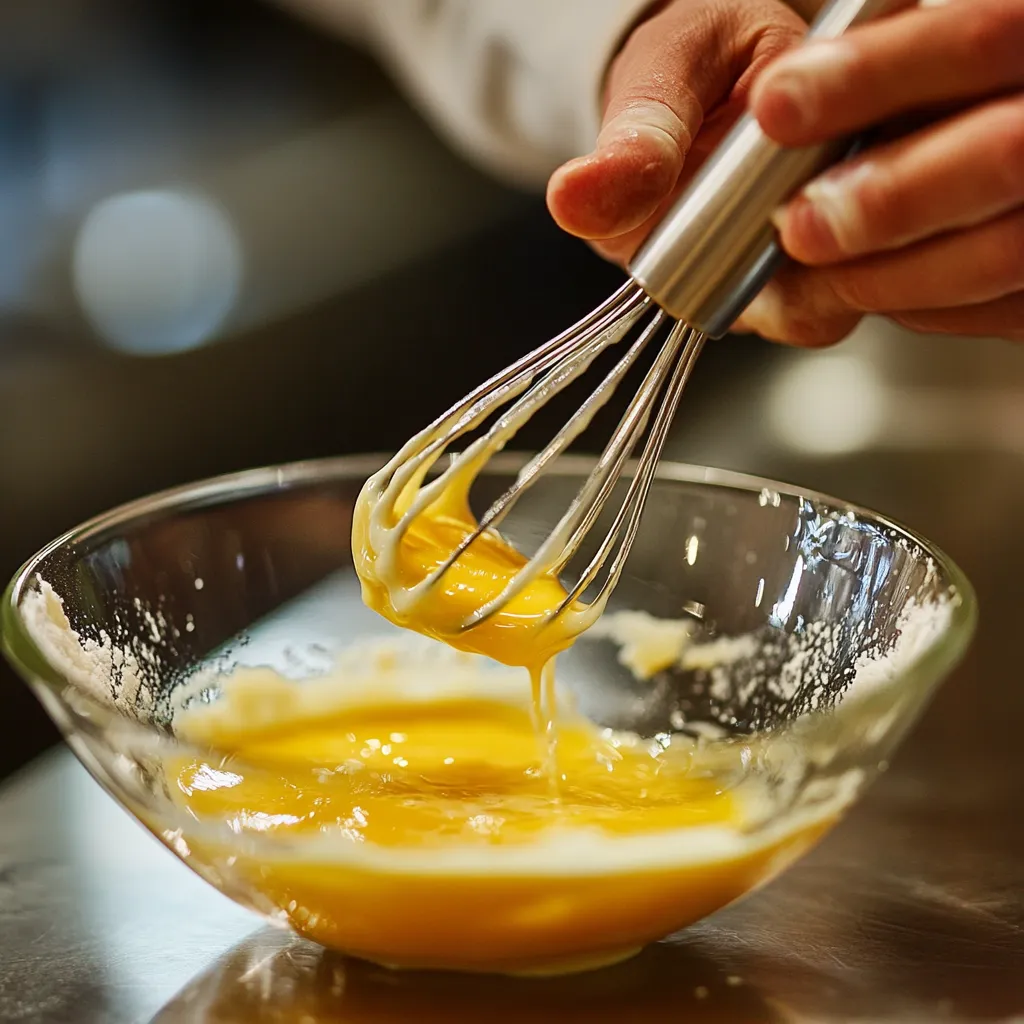
Step-by-Step Custard Preparation
- Heat the Cream: Begin by warming the heavy cream over low heat, ensuring it doesn’t boil. This step allows the sugar and vanilla to infuse smoothly into the cream.
- Whisk the Yolks and Sugar: In a separate bowl, beat the egg yolks and sugar until the mixture is pale and slightly thickened.
- Temper the Yolks: Gradually pour the warm cream into the yolks, whisking constantly to prevent curdling.
- Strain the Mixture: Use a fine mesh sieve to remove any lumps or air bubbles, ensuring a perfectly smooth custard.
Tips for Success
- Always use room-temperature eggs for easier tempering.
- Avoid over-mixing, as it can introduce air bubbles that disrupt the custard’s texture.
- For added flavor, allow the custard mixture to rest for a few minutes before baking.
Mastering the custard mixture is a testament to precision and patience, key traits for any culinary enthusiast aiming to create a flawless crème brûlée.
Part 10: Baking Techniques for Perfect Texture
The secret to a flawlessly creamy crème brûlée lies in its baking method. Unlike other desserts that rely on high heat or rapid cooking, crème brûlée requires gentle, even heating to achieve its characteristic silky texture.
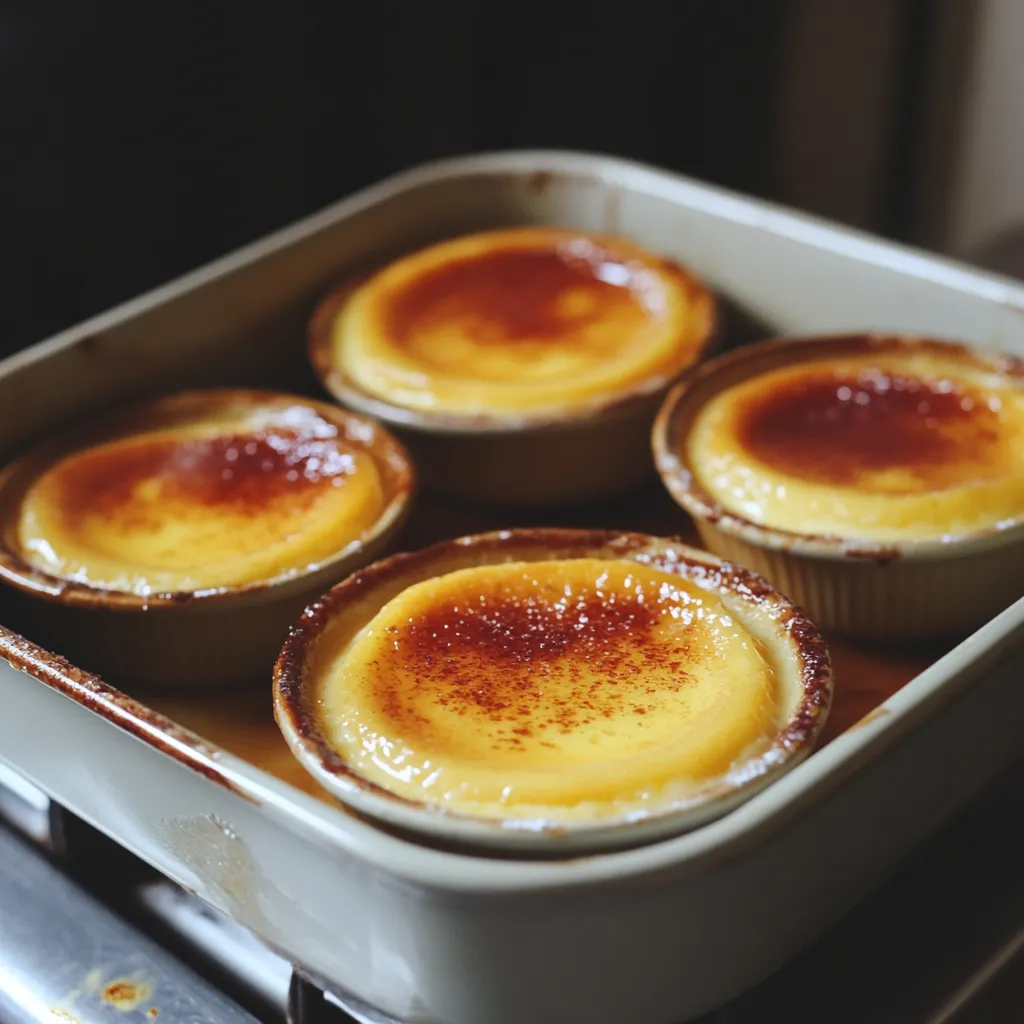
The Bain-Marie Method
Crème brûlée is traditionally baked using the bain-marie, or water bath, technique. This involves placing ramekins filled with custard in a larger baking dish filled with hot water. The water insulates the custard, ensuring it cooks evenly and doesn’t curdle.
Steps for a Successful Bain-Marie:
- Preheat the oven to a low temperature, typically around 325°F (160°C).
- Place the ramekins in the baking dish and pour the custard mixture into each one, filling them almost to the top.
- Add hot water to the dish until it reaches halfway up the sides of the ramekins.
- Cover the dish loosely with aluminum foil to prevent a skin from forming on the custard.
This method prevents the custard from overcooking while maintaining its creamy consistency.
Testing for Doneness
The perfect crème brûlée is set at the edges but still jiggly in the center. After 30-40 minutes of baking, gently tap the side of a ramekin. If the custard wobbles slightly in the middle, it’s ready. Overbaking can cause a grainy texture, so it’s better to err on the side of underbaking.
Cooling and Setting
Once baked, the custard must cool completely before caramelizing the sugar topping. Refrigerate the ramekins for at least two hours (preferably overnight) to allow the custard to firm up. This step is crucial for achieving the dessert’s iconic contrast between the chilled base and the warm, crackly top.
Part 11: Achieving the Signature Caramelized Sugar Topping
No crème brûlée is complete without its crackling, golden sugar crust. This finishing touch transforms the dessert from a simple custard into a multi-textured masterpiece.
Choosing the Right Sugar
Granulated sugar works best for caramelizing, as it melts evenly and forms a crisp, even crust. Avoid powdered or coarse sugar, as these can burn too quickly or create an uneven topping.
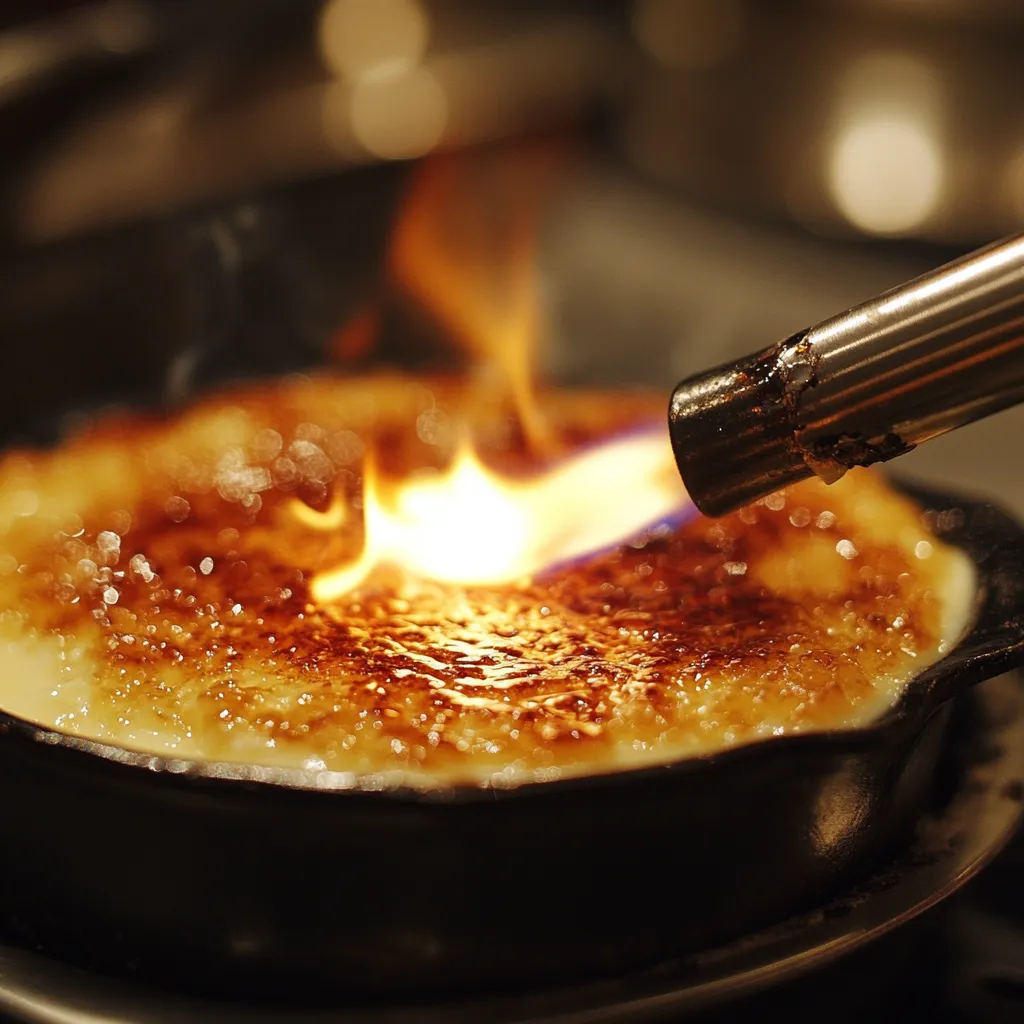
Caramelizing Techniques
- Using a Culinary Torch: The preferred method among chefs, a culinary torch allows for precise control, ensuring the sugar caramelizes without burning. Move the torch in small circles over the surface until the sugar melts and turns golden brown.
- Broiler Method: If a torch isn’t available, a broiler can also achieve good results. Place the ramekins under a preheated broiler for a few minutes, watching closely to prevent the sugar from burning.
Creating the Perfect Crack
For the best experience, aim for a thin, even sugar layer that cracks easily under the pressure of a spoon. This ensures a satisfying crunch without overshadowing the creamy custard beneath.
Caramelizing the sugar is not just about aesthetics—it’s about creating the dramatic interplay of textures that makes crème brûlée a show-stopping dessert.
Part 12: Serving Suggestions and Accompaniments
Crème brûlée’s simplicity makes it versatile enough to serve on its own or alongside complementary flavors and textures.
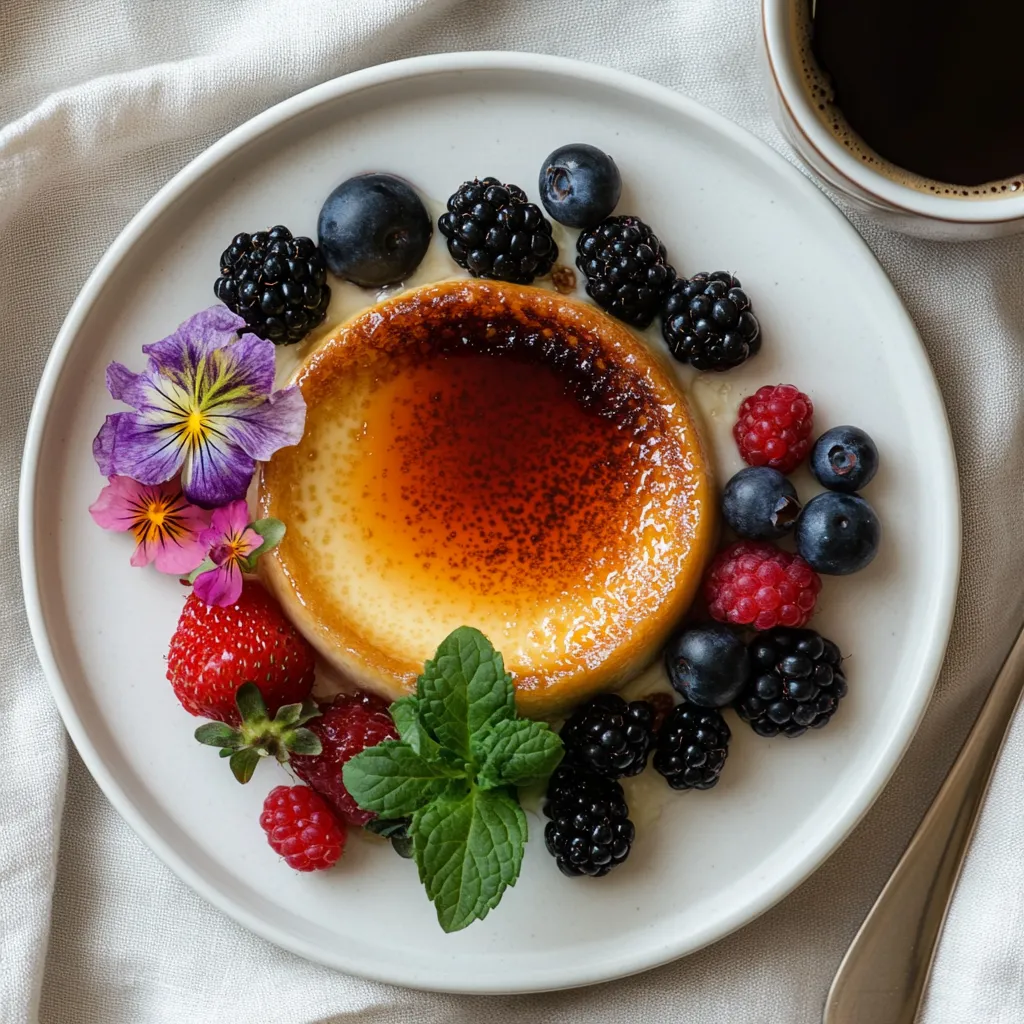
Garnishes for Added Flair
- Fresh Berries: A handful of raspberries, blueberries, or sliced strawberries add a pop of color and a refreshing tartness.
- Mint Leaves: A sprig of mint enhances the dessert’s presentation with its vibrant green hue.
- Edible Flowers: Delicate blooms like violets or pansies elevate crème brûlée into a true work of art.
Pairing with Other Desserts
Crème brûlée pairs beautifully with light, crisp desserts like shortbread cookies or biscotti. The contrast between the crumbly textures and the creamy custard creates a harmonious balance.
Serving Temperature Tips
For the ultimate experience, serve crème brûlée straight from the fridge, ensuring the custard is chilled while the caramelized topping remains crisp and warm.
With its luxurious texture and timeless flavor, crème brûlée is a dessert that never fails to impress, whether served at an intimate dinner or a grand celebration.
Stay tuned as we explore common mistakes to avoid, nutritional information, and answer some frequently asked questions in the next sections!
Part 13: Common Mistakes to Avoid
Despite its simple ingredients, making crème brûlée can be tricky. Even minor missteps can impact the dessert’s texture, flavor, or presentation. By understanding and avoiding these common mistakes, you can ensure your crème brûlée turns out flawless every time.
Overcooking the Custard
One of the most frequent errors is overbaking the custard. Overcooked crème brûlée develops a grainy texture due to the proteins in the egg yolks coagulating too much. To avoid this:
- Bake at a low temperature (around 325°F or 160°C).
- Remove the ramekins from the oven when the custard is set at the edges but still jiggles slightly in the center.
- Cool the custard promptly after baking to stop the cooking process.
Skipping the Bain-Marie
The water bath is essential for even cooking. Without it, the custard can overheat, leading to a lumpy or curdled texture. Always ensure the water in the bain-marie reaches halfway up the sides of the ramekins and is preheated before baking.
Improper Sugar Caramelization
The caramelized topping can be another source of frustration. Uneven sugar distribution, over-torching, or under-torching can result in a disappointing crust.
- Spread a thin, even layer of sugar for consistent caramelization.
- If using a broiler, keep a close watch to avoid burning the sugar.
Using Low-Quality Ingredients
With so few ingredients, the quality of each one matters immensely. Fresh cream, high-quality vanilla, and fresh eggs are non-negotiable for achieving the best flavor and texture.
Failing to Temper the Egg Yolks
Skipping the tempering process or rushing it can cause the egg yolks to curdle when mixed with the warm cream. To prevent this, slowly add the hot cream to the yolks while whisking continuously.
Skipping the Straining Step
Neglecting to strain the custard mixture can leave behind lumps or bubbles that mar the texture of the dessert. Always pass the mixture through a fine-mesh sieve before pouring it into the ramekins.
By avoiding these pitfalls, you’ll master the art of making crème brûlée and enjoy consistently excellent results.
Part 14: Nutritional Information
While crème brûlée is a treat best enjoyed in moderation, understanding its nutritional profile can help you savor it responsibly.
Calorie Breakdown
A typical serving of classic crème brûlée contains approximately:
- 250–300 calories
- 20–25 grams of fat
- 4–5 grams of protein
- 20–25 grams of carbohydrates
The exact numbers may vary based on portion size and specific ingredients used.
Key Nutritional Contributions
- Fats: Primarily from heavy cream and egg yolks, contributing to the dessert’s rich texture.
- Proteins: From the egg yolks, offering a modest amount of protein per serving.
- Sugars: From both the custard base and caramelized topping, providing sweetness and energy.
Healthier Modifications
- Substitute heavy cream with lighter alternatives, such as half-and-half, to reduce fat content.
- Use natural sweeteners like stevia or monk fruit to lower sugar levels.
- Opt for smaller ramekins to control portion sizes without sacrificing flavor.
Crème brûlée is an indulgence, but it can be enjoyed guilt-free when balanced with mindful choices in the rest of your diet.
Part 15: Frequently Asked Questions (Updated)
What is crème brûlée made of?
Crème brûlée is made of heavy cream, egg yolks, sugar, and vanilla extract. These simple ingredients combine to create a rich, creamy custard topped with caramelized sugar for a satisfying crunch.
What does crème brûlée taste like?
Crème brûlée tastes luxuriously creamy with a subtle sweetness and a delicate hint of vanilla. The custard has a rich, smooth texture, while the caramelized sugar topping adds a warm, toasty flavor and satisfying crunch. This combination of textures and flavors makes it an irresistible treat.
Is crème brûlée basically custard?
Yes, crème brûlée is essentially a custard. It is made from a mixture of cream, egg yolks, and sugar, similar to other custard desserts. However, what sets it apart is the caramelized sugar topping, which adds a distinct texture and flavor that’s unique to crème brûlée.
What is the point of crème brûlée?
The point of crème brûlée is to create a dessert that celebrates the harmony of textures and flavors. It combines the silky smoothness of a rich custard with the crunch of caramelized sugar. Beyond its taste, it also offers a multisensory experience, from cracking the crust to savoring the contrast of the chilled custard and warm topping.
Can I make crème brûlée without a torch?
Yes! You can use a broiler to caramelize the sugar topping. Simply place the ramekins under a hot broiler for a few minutes, keeping a close eye to prevent burning.
Why is my custard grainy?
A grainy texture usually indicates overcooking or improper tempering of the egg yolks. Cook the custard gently and always temper the yolks with care.
How long can crème brûlée be stored?
Crème brûlée can be refrigerated for up to three days. However, wait to caramelize the sugar topping until just before serving to maintain its crisp texture.
Can crème brûlée be frozen?
While freezing is not recommended for optimal texture, you can freeze the baked custard for up to two weeks. Thaw it in the fridge and caramelize the topping before serving.
Is crème brûlée gluten-free?
Yes, traditional crème brûlée is naturally gluten-free, making it a great dessert option for those with gluten sensitivities.
Conclusion
Crème brûlée, with its rich custard base and crackling caramelized topping, is a testament to the beauty of simplicity in cooking. From its historical origins to its meticulous preparation, this timeless dessert continues to captivate dessert lovers worldwide. By mastering the techniques and understanding the roles of each ingredient, you can create your own version of this elegant treat and delight everyone at your table.
Enjoy the art of making crème brûlée—it’s as rewarding as it is delicious!

